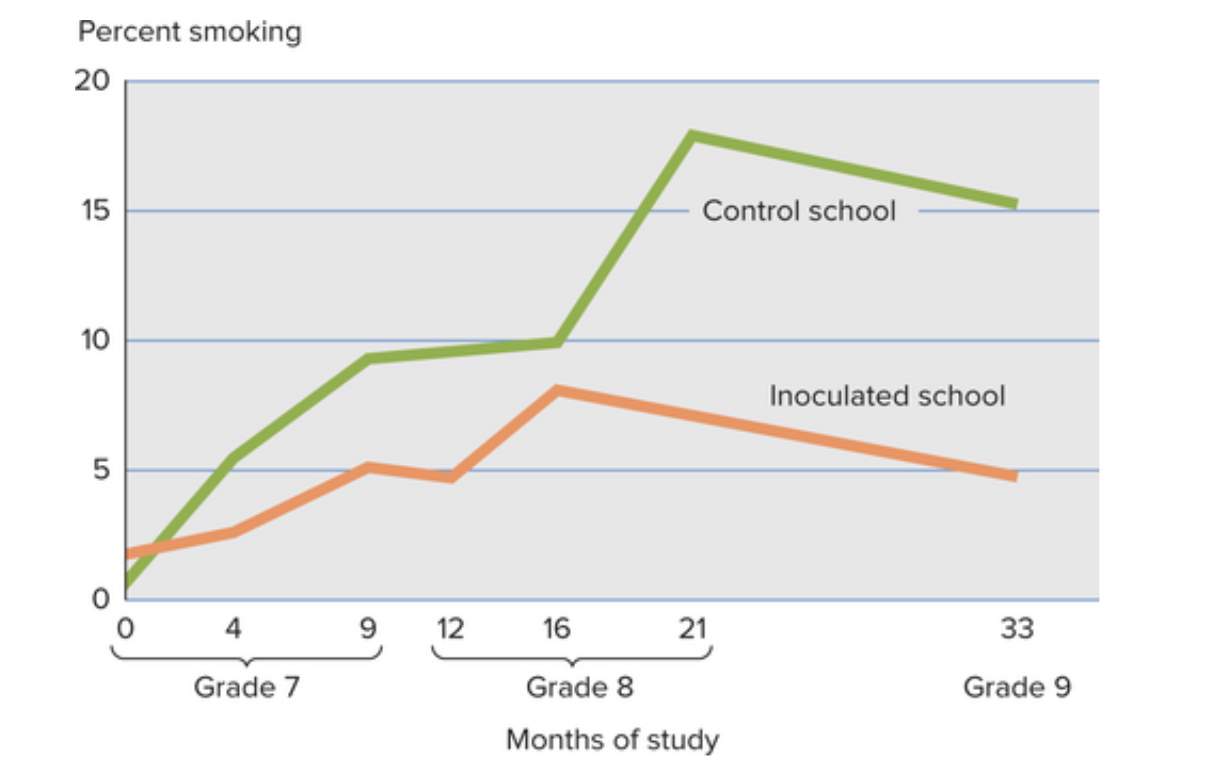Lecture 5 - Persuasion
1/43
There's no tags or description
Looks like no tags are added yet.
Name | Mastery | Learn | Test | Matching | Spaced |
|---|
No study sessions yet.
44 Terms
What does it mean to persuade someone?
It is the process of changing someone’s beliefs/thoughts.

What are the 2 routes to persuasion?
Central Route
Peripheral Route
What is the central route of persuasion?
when we are calculative/analytical about what somebody is saying to us
lots of effort used to think about what’s being said
explicit thinking (conscious thought)
occurs when individuals focus on arguments
usually produces long-term changes in our thinking
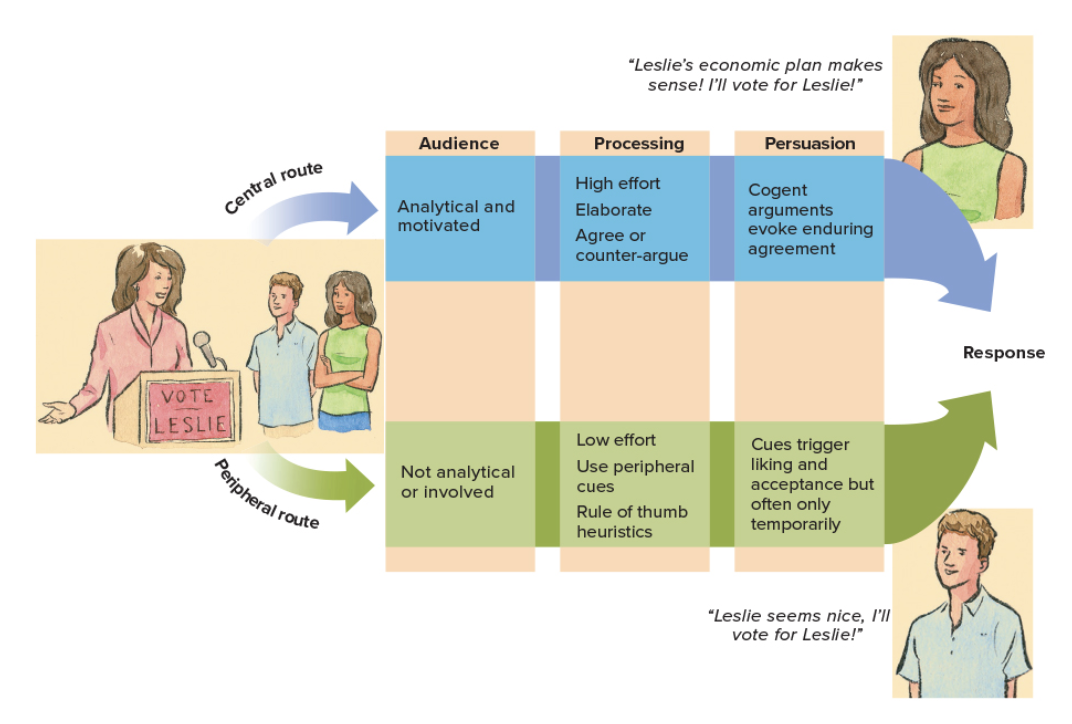
What is the peripheral route of persuasion?
not an analytical route
we don’t put much effort to think about what the person is saying
implicit (automatic thought)
occurs when we focus on incidental cues
temporary attitude change
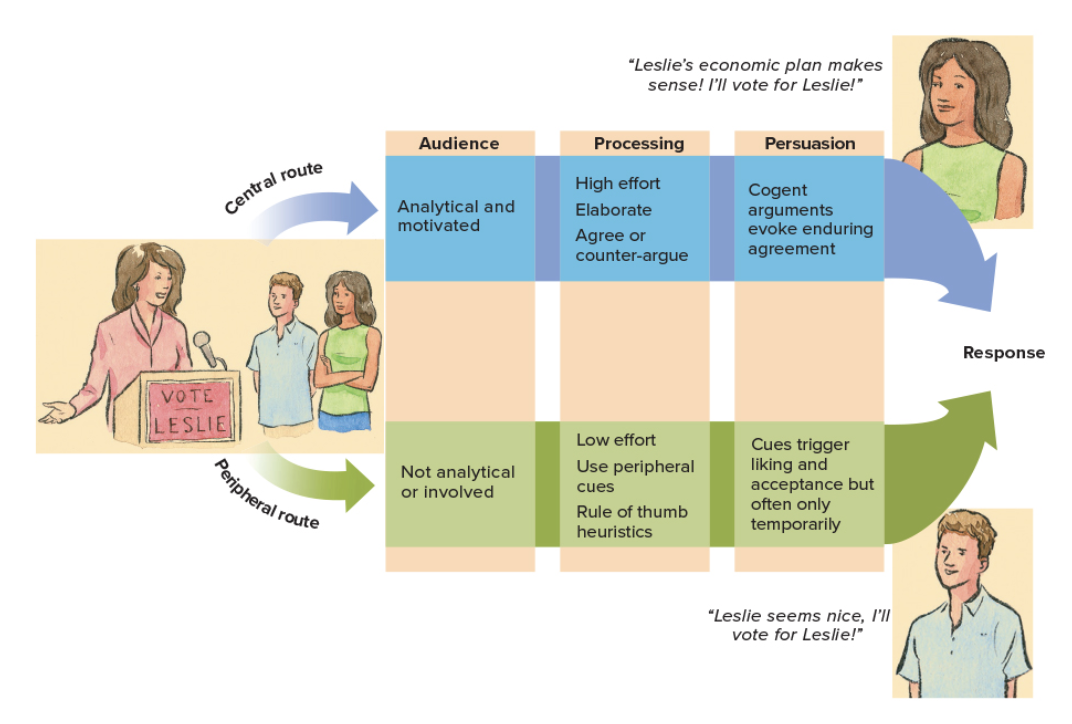
Define incidental cues.
Subtle, often unconscious environmental signals that influence our judgment unintentionally.
For the peripheral route, does the strength of the argument really matter?
Not really, because we tend to focus most on incidental cues for peripheral persuasion.
What are the 4 elements of persuasion?
Communicator
Message Content
Channel
Audience
What’s important about the communicator for persuasion?
Credible
we must perceive expertise
we must perceive trustworthiness\
Attractive
attractiveness is often an incidental cue we use (more attractive we find them, more likely they’ll persuade us)
Similarity
can we relate to them?
if yes, we will likely be more influenced by them
Define the sleeper effect.
When the impact of the message is delayed and so we remember the message but not the source of the info.
What are the 6 principles of persuasion?
Authority (credible)
Liking (attractive, similar)
Social Proof (lots of people like it so easily persuaded)
Reciprocity (feel a need to repay so more easily persuaded)
Consistency
Scarcity (low supply, more easily persuaded)
What’s important about the message?
The message needs to be catered to its audience
Hence, sometimes you need to tap into the reasonable side of people or the emotional side of people
How can the type of message affect how we get persuaded?
The effect of good feelings
if we are put into a good mood, we are more easily persuaded
Fearful messages
if we are sacred it can help reduce negative behaviours and/or increase positive behaviours
What’s an example of a fearful message increasing a positive behaviour? What were the results?
Banks et al (1995)
They framed 2 messages about getting mammogram for breast cancer detection:
gain framed (detecting early can save your life - positive message)
loss framed (not detecting early enough could cost you your life - scary message)
For the gain framed message 50% of women got a mammogram. Pretty good, but could also be connected to chance since its 50%. Whereas, over 60% of the women who read the loss framed message got a mammogram.
Therefore, indicating how arousing fear is a very good persuasive tool.
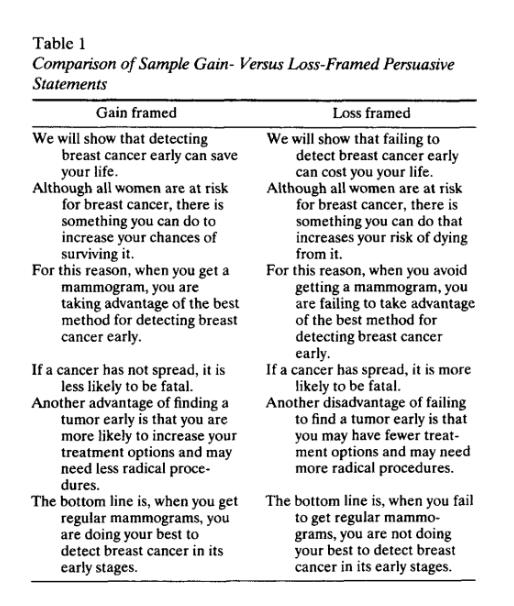
Is fear the ultimate persuasive tool? Why?
No, because if you scare someone too much then they might not wanna do anything because you’ve made it too daunting to them.
Therefore, you can’t make it too scary and you gotta include an attainable solution for your audience. Then, you’ll be persuasive.
How do you know how extreme your message should be?
Effective persuasion depends on both the size of the message discrepancy and the communicator’s credibility.
What’s message discrepancy?
How extreme the message presented is from the original message.
Why does persuasion depend on both the size of the message discrepancy and communicator’s credibility?
Aronson, Turner, and Carlsmith (1963) found that when a credible source (like T. S. Eliot) strongly praised a disliked poem, people shifted their opinions more than when he gave mild praise.
But with a less credible source, strong praise was no more persuasive than weak praise.
Thus, effective persuasion depends on both the size of the message discrepancy and the communicator’s credibility.
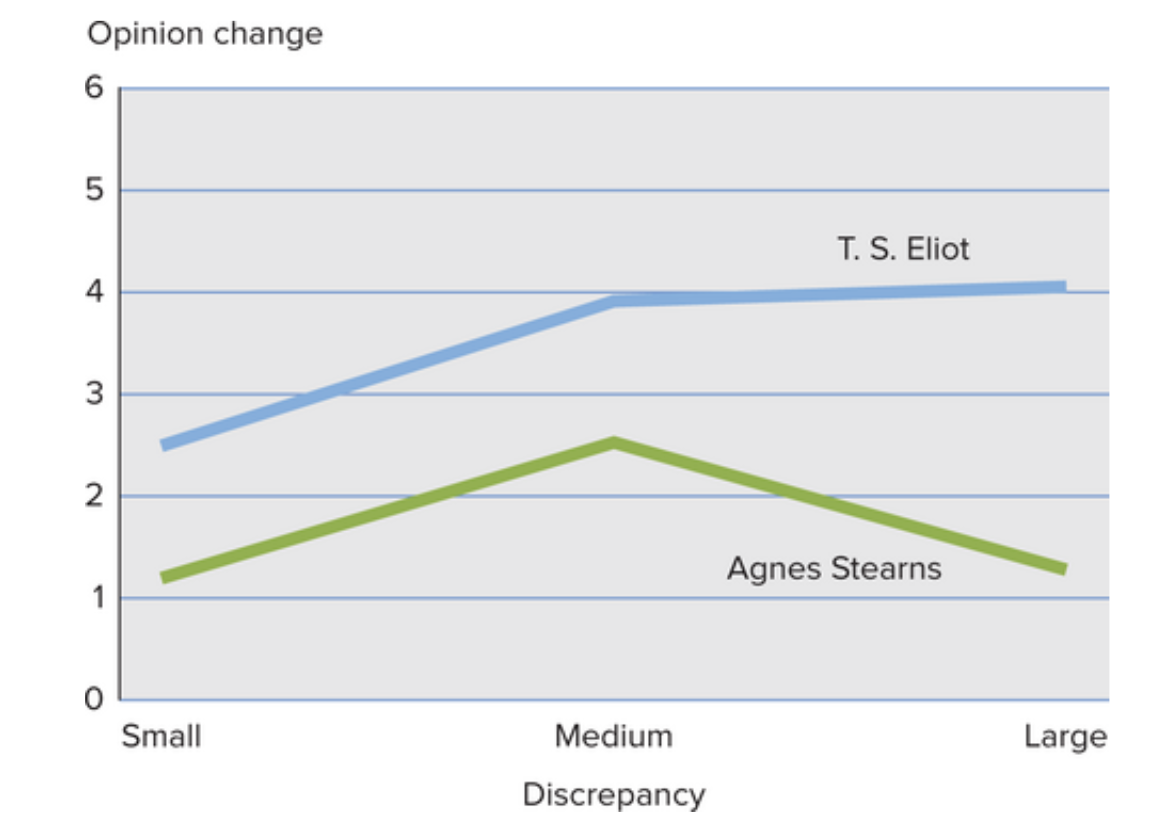
Should you have one-sided or two-sided arguments?
Carl Hovland (1949)
One-sided messages can seem stronger, but two-sided ones often appear fairer and more convincing.
Hence, persuasion works differently depending on audience—use one-sided appeals for supporters, two-sided for informed or opposing groups.
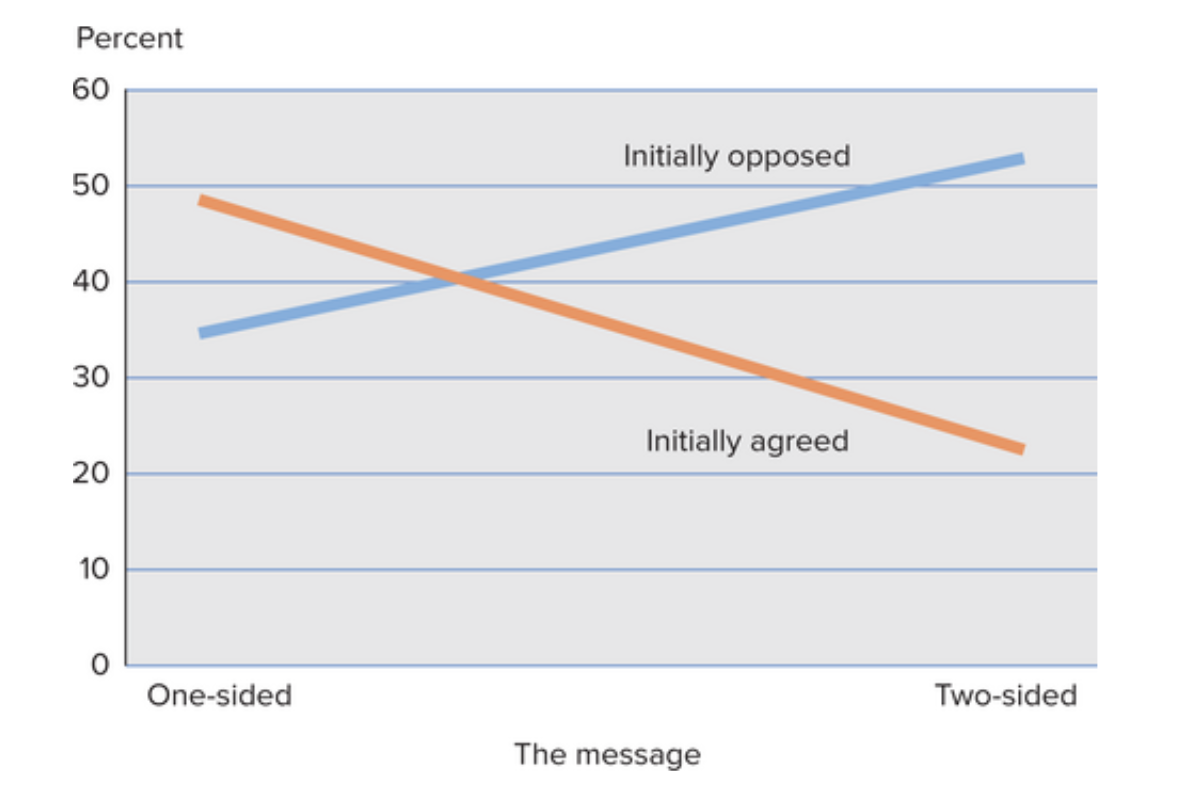
Explain the primacy effect on persuasion.
This occurs when two messages are presented back-to-back with a delay before judgment.
Hence, early information shapes our interpretation of the information and it is remembered better.
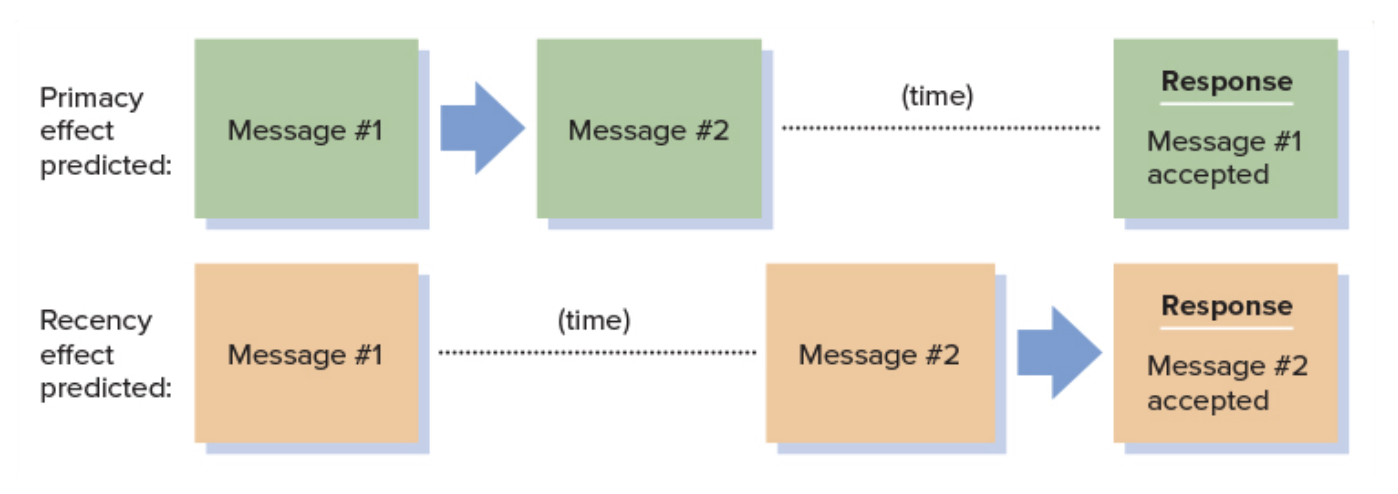
Explain the recency effect on persuasion.
Occurs when messages are separated by time but judgment follows immediately after the second.
Hence, the most recent information dominates.
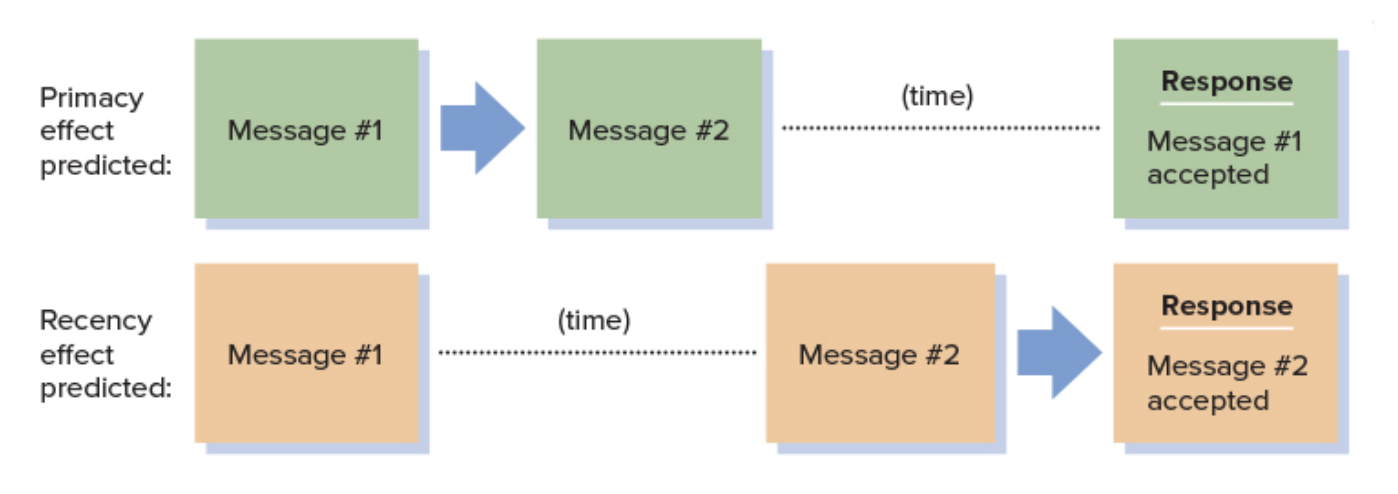
What channel for information is the most effective for persuasion?
Active experiences shape stronger and longer-lasting attitudes.
However, passive appeals rely on repetition and fluency and are thus less effective, especially on important issues.
Are personal interactions or media interactions more effective for persuasion?
Research shows that personal contact influences people a lot more than media.
ie. in political and health campaigns, face-to-face appeals lead to much greater behaviour change than mass media or mailings, demonstrating the power of personal and social influence over impersonal persuasion.
What the process of the media influencing our behaviour/attitudes?
The media, before social media, had a 2 step flow:
media
opinion leaders
public
*but now minus the opinion leaders and jump straight from media to public
How does the media influence our behaviour/attitude?
The opinion leaders like social media influencers, news anchors, talk show hosts, politicians etc… can all shape how we think and therefore how we act as a result of the information we hear from them.
What factor about our audience affects how we present information?
Age effects.
What are the 2 explanations for why age makes us have to change the way we present information?
Life cycle
Generational
What is the life cycle explanation for age effects?
Since they have lived longer and experience more, they become more conscientious of certain things and more opinionated.
What is the generational explanation for age effects?
When the older generation was young, the times were different and so their attitudes were formed according to the social norms of their time
Define forewarning.
When we give someone a warning that we are going to attempt to persuade them.
How does forewarning affect how effective persuasion is?
This typically prompts the person to begin thinking of counter-arguments, making them less likely to budge on their ide
What are the affects of distractions on the effectiveness of persuasion?
since we have a limited capacity for attention, if someone is distracted it could be harder to persuade them because they are just not paying attention and thus don’t care
OR
on the other hand, the distraction could make it easier to persuade someone because the distraction prevents them from being able to form counter arguments (therefore, they use the peripheral route to make a quick decision)
Define the need for cognition.
A term used to describe a person’s tendency to engage in and enjoy effortful cognitive activities, like thinking, reasoning, and problem-solving.
How does the need for cognition affect the effectiveness of persuasion?
When people enjoy thinking and problem solving, it can be harder to persuade them as they’re more likely to take a central route and be more analytical in their thinking when you’re telling them stuff.
What is an experiment about the need for cognition affecting how persuaded people get?
Fabrigar et al. (1998)
He found that when participants did not put a lot of thought into what they were being told, regardless of whether the argument was strong or not, their attitudes changed the same amount.
However, when participants with a need for cognition were tested, the strength of the argument made a huge difference on whether they were persuaded by the argument or not (ie. if their attitudes changed or not). This is because they really dissected what they were being told
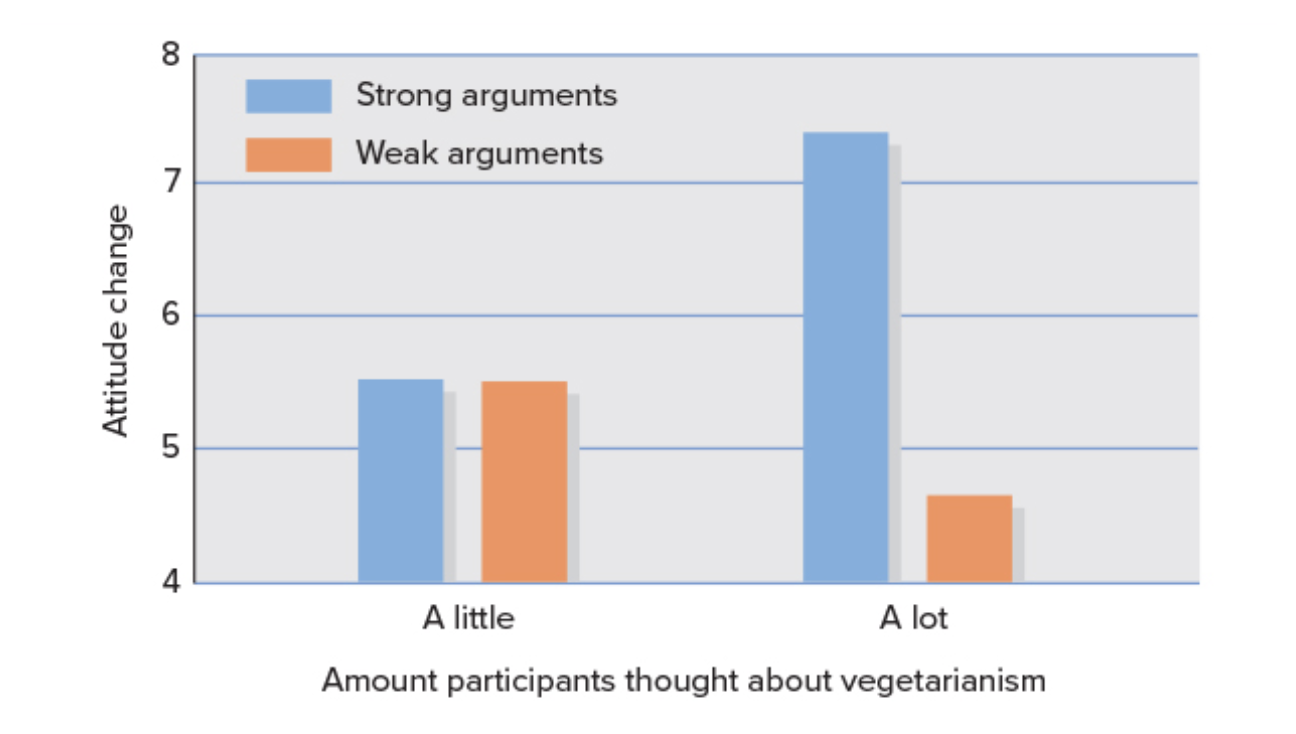
What is an example of extreme persuasion?
Group indoctrination tactics (cults).
How does compliance breed acceptance?
Compliance to do something can lead us to behave in a certain way because the more we comply, the more our attitudes may shift. Hence, our behaviours shifting as a result.
What’s an example of how compliance breeds acceptance?
What are reasons why we resist persuasion?
attitude strength
strong vs. weak attitudes
Information processing bias
selective exposure and attention
selective perception and judgment
selective memory
Reactance
reverse psychology
Strengthening personal commitment
challenging beliefs
developing counter-arguments
How does selective exposure and attention show how we resist persuasion?
This is because, this is when we tend to seek and pay attention to information that only supports our existing attitudes.
Hence, we are resisting persuasion by making sure we only seek and pay attention to information that will tell us that we are right.
How does selective perception and judgment show how we resist persuasion?
It shows how we resist persuasion because it explains how we interpret evidence through our existing beliefs, which makes us process information with a biased perception.
Hence, making us agree with things that support our point.
Define reactance.
When we react in an opposite way because we know someone is trying to persuade us.
*reverse psychology
How does challenging one’s beliefs make them more resistant to persuasion?
By challenging someone’s beliefs mildly it makes one develop counter-arguments to defend their beliefs, therefore lightly nudging them to go more extreme.
What is an experiment that shows the resistance of persuasion via inoculation programs?
McAlister et al.’s (1980)
High school students taught Grade 7 students how to resist peer pressure to smoke.
The younger students learned to counter pro-smoking messages. They also practiced comebacks through role-playing, responding to peer taunts like “You’re chicken” with lines such as “I’d be a real chicken if I smoked just to impress you.”
After these sessions, followed through Grades 7 and 8, the inoculated students were about half as likely to start smoking as those who hadn’t received the training, showing how “attitude inoculation” can build resistance to persuasion.
